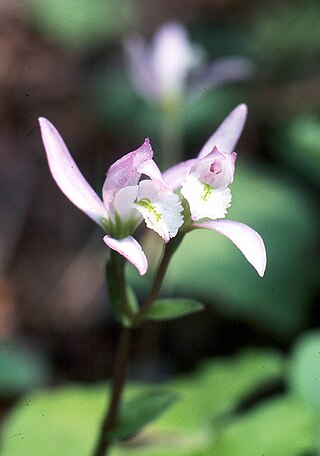
Penstemon, the beardtongues, is a large genus of roughly 280 species of flowering plants native mostly to the Nearctic, but with a few species also found in the North American portion of the Neotropics. It is the largest genus of flowering plants endemic to North America. As well as being the scientific name, penstemon is also widely used as a common name for all Penstemon species alongside beardtongues.

Physocarpus, commonly called ninebark, is a genus of flowering plants in the family Rosaceae, native to North America and northeastern Asia.

Per Axel Rydberg was a Swedish-born, American botanist who was the first curator of the New York Botanical Garden Herbarium.

Pedicularis groenlandica is a showy flowering plant in the family Orobanchaceae which is known by the common names elephant's head, elephant-head lousewort and butterfly tongue.
Artemisia alaskana, the Alaskan sagebrush or Alaskan wormwood or Siberian wormwood, is a North American species of plants in the sunflower family. It is found in British Columbia, the Yukon, the Northwest Territories, and Alaska. Some authors have considered it as a subspecies as the Russian species A. kruhsiana.

Astragalus lentiginosus is a species of legume native to western North America where it grows in a range of habitats. Common names include spotted locoweed and freckled milkvetch. There are a great number of wild varieties. The flower and the fruit of an individual plant are generally needed to identify the specific variety.
Oreochrysum is a genus of flowering plants in the family Asteraceae.
Pseudobahia is a genus of California plants in the tribe Madieae within the family Asteraceae. These plants are known generally as sunbursts.

Chamaechaenactis, common name fullstem, is a genus of flowering plants in the daisy family.

Triphora trianthophoros, the threebirds or three birds orchid, or nodding pogonia, is a species of terrestrial orchid native to eastern North America.

Euphrosyne dealbata, commonly known as copperweed or woolly marsh elder, is a species of plant in the family Asteraceae. It is found in western North America where it is native to northern Mexico, and the south-western United States.
Psathyrotopsis is a genus of North American plants in the tribe Bahieae within the family Asteraceae.
Ericameria obovata, or Rydberg's goldenbush, is a North American species of flowering shrubs in the family Asteraceae. It has been found only in the state of Utah in the western United States.

Erigeron arenarioides is a species of flowering plant in the family Asteraceae known by the common names sand fleabane and Wasatch fleabane. It has been found only in the northern part of the state of Utah in the western United States.
Erigeron mancus is a rare North American species of flowering plant in the family Asteraceae known by the common names depauperate fleabane and imperfect fleabane. It has been found only in southeastern Utah.

Erigeron subtrinervis, called the three-nerved daisy, the three-nerve fleabane, or the hairy showy daisy, is a North American species of flowering plants in the family Asteraceae. It grows in various mountains of western Canada and the western United States: Rocky Mountains, northern Cascades, Black Hills, etc., from British Columbia and Washington state east to North Dakota and south as far as New Mexico.
Heterotheca barbata, the Spokane false goldenaster, is a very rare North American species of flowering plant in the family Asteraceae. It has been found only in the northwestern United States, in eastern Washington and northern Idaho.
Symphoricarpos parishii, or Parish's snowberry, is a North American species of flowering plant in the honeysuckle family. It had been found in California, Nevada, Arizona, and Baja California.

Claytonia rosea, commonly called Rocky Mountain spring beauty, western springbeauty or Madrean springbeauty, is a diminutive spring blooming ephemeral plant with pale pink to magenta flowers. It grows a small round tuberous root and it one of the earliest wildflowers of spring in its range. It is found in dry meadows in forests of ponderosa and Chihuahuan pines, and moist ledges of mountain slopes of the Beaver Dam Mountains of Utah, Colorado Front Range, and Sierra Madre Occidental, south and east to the Sierra Maderas del Carmen of Coahuila.











